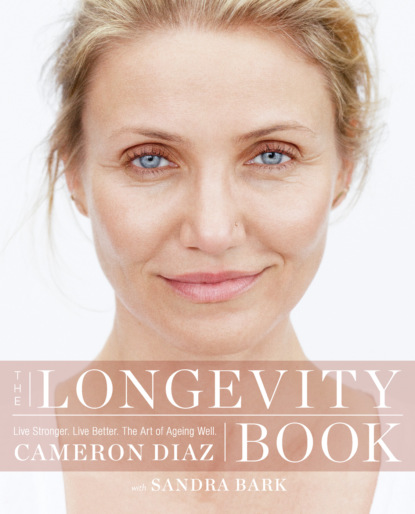По всем вопросам обращайтесь на: info@litportal.ru
(©) 2003-2024.
✖
The Longevity Book: Live stronger. Live better. The art of ageing well.
Автор
Год написания книги
2018
Настройки чтения
Размер шрифта
Высота строк
Поля
You are a lady with millions of microscopic lady cells. Your female cells are special – the genetic information contained in each and every one of them is what makes your body biologically distinct from that of a man. Your female cells have unique characteristics, and so do the organs they make up, because female organs are sized and shaped differently than male organs.
For example, the female heart has a distinct architecture. Our heart is smaller than a man’s, with thin vessels arranged in a lacy pattern instead of the thicker tubes that connect a male heart to his cardiovascular system. Cholesterol plaques can settle (#litres_trial_promo) throughout a woman’s arteries, instead of in a more obvious clump, as tends to happen in men’s hearts, making it more challenging to detect heart disease in women. That is why women experience heart attack symptoms differently than men do, and why they need different care at the hospital during and afterwards. Women are far more likely than men to receive an incorrect diagnosis about heart attack symptoms despite the fact that more women than men die of cardiovascular disease (#litres_trial_promo) every year in the US and the UK.
Our hearts also beat in a distinct rhythm; any disruption of that rhythm results in an irregular heartbeat, called an arrhythmia, which can range in severity from mildly disruptive to life threatening. In addition, some medications and defibrillators – which have primarily been tested on men (#litres_trial_promo) – have been shown to cause potentially fatal complications in women.
Women’s unique biology also translates into unique risk factors for disease. For example, women are more likely than men to develop depression (#litres_trial_promo), eating disorders, and anxiety disorders like post-traumatic stress disorder. Mental health issues are, in turn, a risk factor for a variety of other diseases. A twelve-year study of more than 10,000 women in Australia aged 47–52 showed that middle-aged women who were depressed have twice the risk of having a stroke (#litres_trial_promo) compared to women who are not depressed.
But until the past few decades, nobody was talking about female cells, and it’s taken some time for the medical and scientific communities to realize just how important it is to consider the sex of our cells when it comes to healthcare. Today, with an improved understanding of how sex-specific biology affects research, diagnostics, and medical treatment, women are getting better care.
HOW DO CELLS GET A SEX?
Healthy people have forty-six chromosomes (#litres_trial_promo) in each of their cells. Two of your forty-six chromosomes determine sex. The rest, the autosomes, determine pretty much everything else about you. Sex chromosomes only come in two varieties: X and Y. Women are XX and men are XY. The X chromosome is much larger than the Y chromosome, because it is a powerhouse: not only does it determine sex, it also contains additional genes and thus additional information. The Y chromosome is smaller and carries less information.
Your sex is determined by your father. When a sperm, which has twenty-three chromosomes, twenty-two autosomes, and one sex chromosome, collides with an egg, which has twenty-three chromosomes, twenty-two autosomes and one sex chromosome, fertilization takes place. The result is a complete human cell – called a zygote.
Since all of a woman’s cells have an XX, her eggs can only have an X. Since men have an XY, their sperm can contain either an X or a Y. It’s a toss-up. Will a fertilized egg become a female or a male? It’s all about the sex chromosome carried by the sperm (#litres_trial_promo).
If you are a woman, the sperm that made you carried an X chromosome. As the female zygote divided, all the cells it made were female, and thus, so are you. A zygote divides and replicates and divides and replicates and divides and replicates. And after all that replication, you’ve got a cluster of female embryonic stem cells that will eventually keep dividing to become heart cells and liver cells and skin cells and blood cells and brain cells. And all those resultant organs will be female organs made up of female cells.
The genes located along the X chromosome are called sex-linked genes; some of them are coded specifically for female anatomical traits, but other genes are responsible for more than three hundred genetic diseases, known as X-linked disorders. The fact that we have two X chromosomes in each of our cells may actually be one reason why women live longer than men – if one of our Xs contains a faulty gene (#litres_trial_promo), we have another X to step in. One example of this is red-green colour blindness (#litres_trial_promo), a common X-linked disorder. More men than women are colour-blind, because if the gene for colour is disturbed on their X chromosome, they don’t have a second one to use for backup. Having two Xs is like having an extra little black dress in the closet – or even better, having a few extra years of life in which to wear it.
HYSTERIA AND HAPPY ENDINGS
For centuries, the medical community viewed women as simply smaller versions of men with different reproductive organs – organs that were thought to make us mentally unstable. You can go to a library and view 1,500 years’ worth of medical journals – from classical Greek texts to Victorian literature – that record “hysteria” as a common diagnosis for women. The word “hysteria” is actually derived (#litres_trial_promo) from the word hysterikos, Greek for “of the womb.”
If a woman seemed psychologically stressed, or she started forgetting things, or she seemed emotionally volatile, like she needed too much attention, a physician might diagnose her with hysteria. Remedies ranged from sniffing smelling salts to having sex. A single woman would be advised to marry. Married women were advised (#litres_trial_promo) to sleep with their husbands or to go horseback riding. Alternatively, in a not uncommon practice, doctors and midwives would use their fingers to stimulate women to orgasm (#litres_trial_promo), or “hysterical paroxysms” – basically a happy ending at the doctor’s office.
As recently as the late nineteenth century, nearly three-quarters of the female population (#litres_trial_promo) were deemed to be “out of health”, including women with “a tendency to cause trouble”. Since their issues generally couldn’t be resolved in just one visit, these women represented America’s largest therapy services market.
In 1980, “hysterical neurosis” was finally dropped (#litres_trial_promo) as an official diagnosis by the American Psychiatric Association.
Just another reason to be grateful that you’re a lady.
THE FALL OF BIKINI MEDICINE (#litres_trial_promo)
If you ask a female doctor in her fifties about the model for human anatomy she studied in med school, she will tell you about the 70kg (approximately 11 stone) man that was the example for her medical training – and his female companion, the 60kg (approximately 9½ stone) man with boobs and a uterus. Medical students were not trained to treat the male and female bodies as all that different, except when it came to the reproductive organs – the areas covered by a bikini. Hence the nickname for the medical education of the era: bikini medicine.
Bikini medicine was the product of centuries of misunderstanding about female anatomy that began with all that hysteria about hysteria. The fall of this antiquated model and the rise of our more accurate understanding of female biology is tied in large part to the strides made by a generation of thinkers and speakers and brave, determined individuals who demanded change as a part of the Women’s Rights Movement. The modern view of women’s health we take for granted today only began in the 1960s, as women in Western society sought information about their biology and demanded better-quality medicine, including better reproductive care and uninhibited reproductive rights. They made it clear to lawmakers and medical professionals that women’s legal rights and medical welfare were inextricably linked.
Here’s one example: the year that I was born, 1972, was the same year that the federal government allowed unmarried women legal access to birth control. Think about that. If you were a single woman in 1970, it was actually illegal for you to take charge of your reproductive system. In 1989, when I was seventeen, Congress allocated funds specifically for the study of women’s health. By the 1990s, 30 per cent of ob-gyn specialists were women (#litres_trial_promo), up from just 7 per cent in the 1960s. Their efforts, along with the efforts of countless other doctors and scientists, increased the focus and attention on women’s health, including the health of older women, setting the stage for the healthcare we will all receive in the years to follow.
A BRIEF HISTORY OF WOMEN’S MEDICINE IN THE UNITED STATES
1916:
Margaret Sanger opens (#litres_trial_promo) the first birth-control clinic in Brooklyn. Ten days after it opens, the police shut it down and put her in prison. Contraception is illegal.
1916:
Planned Parenthood is founded.
1920:
Women get the right to vote
1960:
The birth-control pill is approved by the Food and Drug Administration (FDA).
1960s:
The women’s health movement begins.
1963:
Congress passes the Equal Pay Act.
1967:
The National Organization for Women (NOW) is launched.
1971:
Ten per cent of medical students are women.
1972:
Eisenstadt v. Baird establishes the right of unmarried women to use the birth-control pill.
1973:
Roe v. Wade gives women the option of a safe and legal abortion.
1989:
The Supreme Court allows states to make abortions in public hospitals illegal.
1990:
Congress passes the Women’s Health Equity Act, and dedicates federal funds to research on women’s health.
1993:
Congress mandates that scientists must include women in clinical trials in order to be eligible for federal funding.
1996:
Perimenopause is defined by the World Health Organization.







